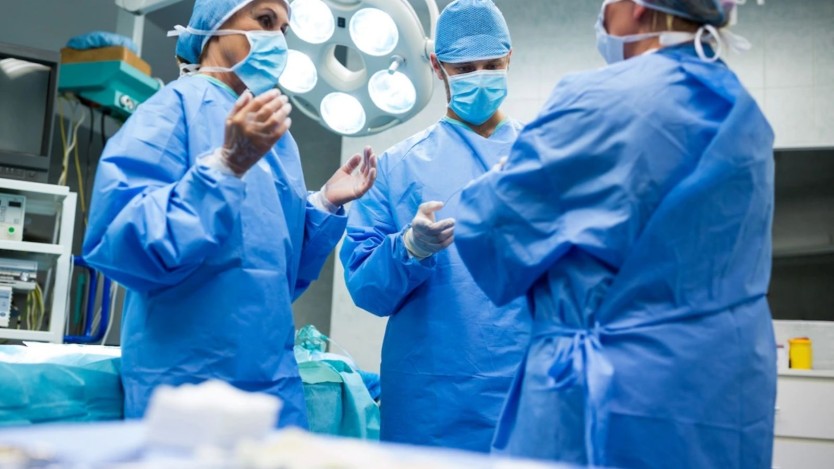Ventral hernia: what it is, causes, symptoms and treatment

- What are ventral hernias?
- Types of ventral hernias
- Why does a ventral hernia occur? Causes
- Symptoms of ventral hernias
- Diagnosis of a ventral hernia
- Treatment of a ventral hernia
- A ventral hernia arises as a consequence of a weakening in the abdominal wall, which can be due to different causes that we explain throughout this article.
- Ventral hernias can be epigastric hernia, umbilical hernia, incisional hernia and Spiegel's hernia, all of which are located in the abdominal area.
- Ventral hernias can only be completely removed in one way: by surgery, either laparoscopic or open.
What are ventral hernias?
If we talk about hernias in general, we can define them as a protrusion of the intestine due to a weakening of the abdominal wall, which manifests itself in the patient as a bulge or hernial sac that can be seen and felt perfectly. Hernias can be of different types depending on where they are located: inguinal hernia, abdominal hernia, umbilical hernia, epigastric hernia, femoral hernia, etc.

Do you need epigastric hernia surgery?
Request a free and immediate appointment with our specialists
In this specific case, ventral hernias are those that are only located in the abdominal area, i.e. among them we can find umbilical hernia, epigastric hernia, Spiegel's hernia and incisional hernias also caused in the abdominal area, i.e. those that are the consequence of an operation previously performed in the area.
It should be noted that the inguinal hernia, for example, is not included in the group of ventral hernias, due to its location in the groin area.
Types of ventral hernias
As mentioned above, ventral hernias can be of various types, depending on the area of the abdomen where they are located.
Umbilical hernia
Umbilical hernias are those that occur, as the name suggests, in the umbilical area or navel area, where the umbilical cord was located during the gestation period. This type of hernia is usually caused by a congenital weakness in the abdominal wall, i.e. present from birth. This type of hernia can occur in patients at any age.
Epigastric hernia
These are hernias that occur in the upper abdomen, i.e. between the sternum and the navel. Normally this type of hernia is caused by overexertion in the area, such as weight lifting, constipation, etc.

Spiegel hernia
This type of ventral hernia is less common (approximately 1% of cases). It is also located in the abdomen, although in a more specific area called the Spiegel's lunate line.
Incisional hernia
These hernias occur in the area where a surgical incision has previously been made. They occur mainly in the abdominal area. They usually develop when there is a failure of the stitches or in an area close to the stitches. Incisional hernias can be caused by both overexertion of the area and health problems.
Why does a ventral hernia occur? Causes
As mentioned above, ventral hernias occur due to a weakening in the patient's abdominal wall, which causes a bulge that manifests as a lump in the abdomen.
But what causes the weakness in the abdominal area? Sometimes the weakness is congenital, which means that the abdominal wall may not form properly during the gestation period of the foetus inside the mother's womb.
This results in being born with a defect in the abdomen, which can later lead to ventral hernia.
Other times, ventral hernias are asymptomatic, i.e. they do not show any symptoms despite the weakening of the abdominal wall. In these cases, the hernia can manifest itself at any time when we make any effort in the abdomen, such as:
- Vigorous physical exercise.
- Lifting heavy objects.
- Straining when going to the toilet (especially when suffering from chronic constipation).
- Chronic coughing and, as a consequence, constant abdominal straining.
- Straining when urinating because of an enlarged prostate.
- Being overweight, which causes pressure in the abdomen.
In general, any abdominal strain can cause a weakening of the abdominal wall and lead to a ventral hernia. Pregnancy, ageing or a previous incision made in the area can also cause tissue weakness.

Specifically, epigastric hernias are more common in men than in women, and umbilical hernias are more common in many pregnant women during the gestation period or even during childbirth.
Symptoms of ventral hernias
The main symptom of a ventral hernia is a bulge in the patient's abdomen. It can be seen and touched and looks like a protruding bulge (called a hernia sac) in the abdominal area. As mentioned above, ventral hernias are located in the abdomen.
It should be noted that it is the hernia sac that allows the specialist to make a correct diagnosis of the hernia.
The lump is soft to the touch and it is possible that if we put pressure on it, it may move into the abdomen, although it will reappear when we stop putting pressure on it.
Another symptom of ventral hernias can be pain, which occurs especially when pressure is applied to the abdomen. For example, pain may occur when coughing or lifting heavy objects. In such cases, the specialist may recommend the patient to wear an abdominal binder to relieve the pain. This is especially recommended for pregnant women.

In some cases, the ventral hernia may become incarcerated or strangulated, which means that it can become trapped in the hernial orifice because the orifice is too narrow and can cause a lack of blood supply to the area. In these cases the hernia causes the patient a lot of pain and he/she should see a specialist immediately, as immediate surgery is required to repair the problem. In order to prevent the ventral hernia from becoming strangulated, it is best to see a specialist as soon as possible and have it treated.
Other symptoms such as nausea, constipation or very little urination may be signs of a ventral hernia.
Diagnosis of a ventral hernia
To diagnose a ventral hernia, the doctor will first look for and palpate the hernia bulge in the abdomen. The specialist, for a better diagnosis, may ask the patient to make some abdominal effort, such as coughing, etc.
To confirm the diagnosis, the specialist may order a series of tests, which may include the following:
- Ultrasound: this allows the specialist to see how the tissues and organs inside the abdomen are located.
- CT (Computerised Axial Tomography): this is a test that uses X-rays to show the doctor a series of images of the inside of the patient's abdomen. These images can show whether or not you have a hernia, how big it is and what is causing it.
These tests are not normally necessary, but in some cases the specialist may request them.
Treatment of a ventral hernia
Although it is true that the hernia may disappear when we put pressure on it, this does not mean that it has disappeared forever, since the weakness in the abdominal wall still exists and will therefore reappear at any moment when we stop putting pressure on it.

On the other hand, when the patient feels a lot of pain due to the hernia, the specialist may recommend pharmacological treatment, i.e. taking medication to eliminate the pain.
It should be noted that eliminating the pain caused by the ventral hernia does not mean that it will disappear, so the only way to make the ventral hernia disappear completely is by surgery.
Surgery is the only way to repair the defect in the patient's abdominal wall, and there are several ways to do this:
Hernioplasty to remove a ventral hernia
Hernioplasty is one of the most common techniques for the removal of ventral hernias, which consists of placing a surgical mesh of synthetic material in the patient's abdominal defect. Hernioplasty can be performed using two techniques: open hernioplasty or laparoscopic hernioplasty.
Open hernioplasty
This technique consists of opening the patient and examining and intervening on the inside of the abdomen. Open hernioplasty for ventral hernia is performed as follows:
- First, the patient is anaesthetised so that he or she cannot feel anything during the operation.
- Once the patient is anaesthetised, the surgeon makes an incision of about 5-10 centimetres to reach the hernia defect.
- Once the surgeon has reached the hernia defect, the part of the intestine that was outside the hernia defect is inserted into the abdomen.
- Once reintroduced, the specialist will place a surgical mesh where the hernial defect is located, so that it performs the function of the abdominal wall and prevents the protrusion from occurring again.
- Finally, the specialist will close the wound with stitches.
Laparoscopic hernioplasty
Unlike open surgery, in this type of surgery only a few small incisions are made to repair the ventral hernia. The surgery is performed as follows:
- First, the patient is anaesthetised.
- As mentioned above, the surgeon then makes 3 or 4 small incisions in the area of the ventral hernia to be operated on.
- Through one of the incisions made, the specialist inserts a laparoscope (a surgical instrument with a tiny camera and a light source at one end, which allows the doctor to see inside the patient's abdominal cavity).
- Through the other incisions made, the specialist inserts other surgical elements that will allow him to operate on the patient correctly.
- Once the ventral hernia has been repaired, the surgeon also places a surgical mesh made of synthetic material in the damaged area of the abdomen to strengthen the area and prevent the hernia from recurring.
- Finally, the surgeon sutures the surgical wounds.
Laparoscopic hernioplasty has some advantages over open hernioplasty, some of them are the shorter recovery time for the patient and the size of the scars, which in this case will be almost imperceptible due to the tiny size of the incisions made.
Another point in favour of hernioplasty over herniorrhaphy (which we will explain below) is the patient's postoperative pain, which will be less in the case of hernioplasty.

As for the duration of the operation, open surgery lasts 30 to 40 minutes, while laparoscopic surgery lasts 90 to 120 minutes.
Herniorrhaphy to remove a ventral hernia
Herniorrhaphy consists, like hernioplasty, of reintroducing the hernia into the patient's abdominal cavity. Unlike hernioplasty, in this case a surgical mesh is not placed on the patient once the hernial defect has been repaired; instead, once the hernia has been reintroduced, the surgeon will place stitches in the affected area.

Do you need epigastric hernia surgery?
Request a free and immediate appointment with our specialists
Medical disclaimer: All the published content in Operarme is intended to disseminate reliable medical information to the general public, and is reviewed by healthcare professionals. In any case should this information be used to perform a diagnosis, indicate a treatment, or replace the medical assessment of a professional in a face to face consultation. Find more information in the links below:
